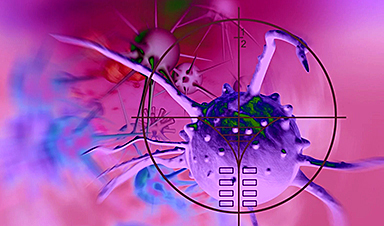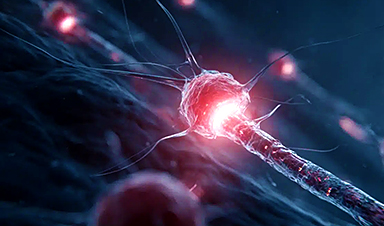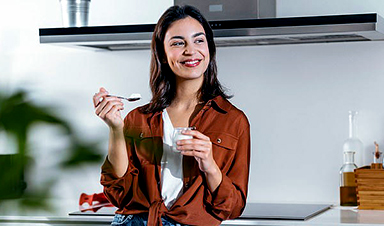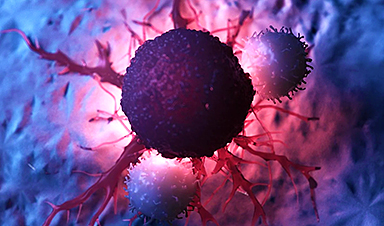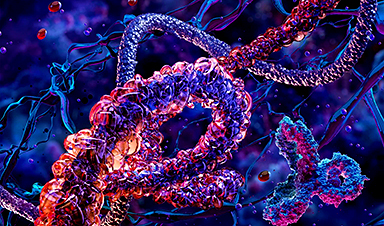Single-cell level protein analysis utilizing mass spectrometry (MS) with picolitre sample volumes needs sensitivity in the range of zeptomole to attomole. An article published recently in the journal Analytical Chemistry discussed an analytical pretreatment method based on a nanofluidic device to downsize the chemical unit operations to the range of femtoliter to picolitre volume in mass spectrometry.
Although mass spectrometry has achieved ultra-high sensitivity detection, preventing sample loss and interfacing between femtolitre to picolitre volumes for pretreatment remains a challenging issue. In this study, the researchers utilized a nanofluidic device to achieve a high-sensitivity detection at the MS interface. Followed by charging analyte molecules by the electrodes, the nanofluidic device helped in the conversion of liquid samples to femtoliter droplets.
After the generation of droplets by a nanofluidic device, an inertial force acted on the sample femtoliter volumed droplet to carry it with a controlled trajectory. Finally, the droplet gets injected into the mass spectrometer instrument. A module was designed and constructed for heat transfer which vaporized all the injected droplets into gas-phase ions. Detecting caffeine ions utilizing the designed MS interface based on a nanofluidic device showed a limit of detection (LOD) of 1.52 attomole.
Compared to the conventional mass spectrometry interface that utilizes electrospray ionization, the present interface based on a nanofluidic device achieved 290 times higher efficiency. Moreover, a 100% sample injection rate was achieved through the nanofluidic method, which resulted in a two-fold higher sensitivity. Thus, the developed methodology based on a nanofluidic device facilitated the analysis of samples in ultrasmall quantities with high sensitivity.
Mass Spectrometry Interface for High Detection Sensitivity
Nanofluidic studies fabricate nanofluidic devices or nanopatterning to achieve a small size. It can achieve nanofluidic manipulation for biological structures and nanoparticles at a nanoscale level. MS-based protein analysis at the single-cell level helps elucidate disease mechanisms and cellular expressions.
Nevertheless, these protein analysis processes need the integration of a pretreatment based on a nanofluidic device to prepare ultrasmall sample volumes before their introduction into a mass spectrometer to facilitate dispersion and prevent sample loss. While microfluidics allows chemical operations in 10 to 100 micromolar spaces, nanofluidics exploits 100−1000 nanomolar spaces with femtolitre to picolitre volumes.
Electrospray ionization (ESI) is a widely used MS interface, which involves applying high voltage to a liquid sample followed by spraying the sample through a capillary, via the electrical repulsive force for ionization. Thus, the sample dispersion by spraying caused by ESI reduces the rate of sample injection into the mass spectrometer, consequently reducing the sensitivity. To this end, nanoESI had reduced capillary size and was extensively used for enhanced sensitivity.
Moreover, MS interfaces utilizing ultrasonic waves and laser ablation to vaporize and eject liquid samples were reported. The piezoelectric interface is another method that shoots sample droplets like an inkjet printer. However, droplets of nanoliter volume are too large to produce gas-phase ions by vaporizing the sample solution.
Femtoliter-droplet MS Interface Utilizing Nanofluidic Device
In their previous work, the team developed a microfluidic device, which utilized a two-step airflow to convert the liquid sample into uniform droplets, followed by their ejection into the air with a controlled trajectory. The droplets generated in this study were of volume between 4 and 25 picolitres. However, this volume range was too large for vaporization.
In the present study, an MS interface based on a nanofluidic device was developed to generate ultrasmall droplets and achieve high-sensitivity analyses, wherein femtoliter-droplet shooter was utilized without sample dispersion. An analytical system was developed with a nanofluidic device integrated MS interface based on a single quadrupole mass spectrometer to prove this principle.
Through the MS interface, which was based on a nanofluidic device, femtoliter droplets were generated. The force that acted on the generated sample droplets carried them with a controlled trajectory and injected them into a mass spectrometer with 100% efficiency. Later, the constructed heat transfer module vaporized the droplets to produce gas-phase ions.
The constructed MS system integrated with an MS interface based on a nanofluidic device helped evaluate the MS detection sensitivity. Results were compared to that of conventional ESI-MS. The results confirmed that the constructed MS interface based on a nanofluidic device detected ultrasmall samples with ultrahigh sensitivity.
What Did the Study Find?
To summarize, the nanofluidic device-based MS interface method was developed to generate femtoliter droplets, which were ejected with a controlled trajectory to achieve high-sensitivity detection. Furthermore, the heat transfer thermal system achieved 100% vaporization of droplets injected into MS’s aperture.
The voltage applied increased the charge imposition efficiency in the sample liquid and the results revealed that the MS interface based on a nanofluidic device achieved high-sensitive MS detection. The ionized caffeine showed 290 times higher sensitivity of detection than conventional ESI due to the achieved femtoliter droplet via MS interface based on a nanofluidic device.
News
Repurposed drugs could calm the immune system’s response to nanomedicine
An international study led by researchers at the University of Colorado Anschutz Medical Campus has identified a promising strategy to enhance the safety of nanomedicines, advanced therapies often used in cancer and vaccine treatments, [...]
Nano-Enhanced Hydrogel Strategies for Cartilage Repair
A recent article in Engineering describes the development of a protein-based nanocomposite hydrogel designed to deliver two therapeutic agents—dexamethasone (Dex) and kartogenin (KGN)—to support cartilage repair. The hydrogel is engineered to modulate immune responses and promote [...]
New Cancer Drug Blocks Tumors Without Debilitating Side Effects
A new drug targets RAS-PI3Kα pathways without harmful side effects. It was developed using high-performance computing and AI. A new cancer drug candidate, developed through a collaboration between Lawrence Livermore National Laboratory (LLNL), BridgeBio Oncology [...]
Scientists Are Pretty Close to Replicating the First Thing That Ever Lived
For 400 million years, a leading hypothesis claims, Earth was an “RNA World,” meaning that life must’ve first replicated from RNA before the arrival of proteins and DNA. Unfortunately, scientists have failed to find [...]
Why ‘Peniaphobia’ Is Exploding Among Young People (And Why We Should Be Concerned)
An insidious illness is taking hold among a growing proportion of young people. Little known to the general public, peniaphobia—the fear of becoming poor—is gaining ground among teens and young adults. Discover the causes [...]
Team finds flawed data in recent study relevant to coronavirus antiviral development
The COVID pandemic illustrated how urgently we need antiviral medications capable of treating coronavirus infections. To aid this effort, researchers quickly homed in on part of SARS-CoV-2's molecular structure known as the NiRAN domain—an [...]
Drug-Coated Neural Implants Reduce Immune Rejection
Summary: A new study shows that coating neural prosthetic implants with the anti-inflammatory drug dexamethasone helps reduce the body’s immune response and scar tissue formation. This strategy enhances the long-term performance and stability of electrodes [...]
Scientists discover cancer-fighting bacteria that ‘soak up’ forever chemicals in the body
A family of healthy bacteria may help 'soak up' toxic forever chemicals in the body, warding off their cancerous effects. Forever chemicals, also known as PFAS (per- and polyfluoroalkyl substances), are toxic chemicals that [...]
Johns Hopkins Researchers Uncover a New Way To Kill Cancer Cells
A new study reveals that blocking ribosomal RNA production rewires cancer cell behavior and could help treat genetically unstable tumors. Researchers at the Johns Hopkins Kimmel Cancer Center and the Department of Radiation Oncology and Molecular [...]
AI matches doctors in mapping lung tumors for radiation therapy
In radiation therapy, precision can save lives. Oncologists must carefully map the size and location of a tumor before delivering high-dose radiation to destroy cancer cells while sparing healthy tissue. But this process, called [...]
Scientists Finally “See” Key Protein That Controls Inflammation
Researchers used advanced microscopy to uncover important protein structures. For the first time, two important protein structures in the human body are being visualized, thanks in part to cutting-edge technology at the University of [...]
AI tool detects 9 types of dementia from a single brain scan
Mayo Clinic researchers have developed a new artificial intelligence (AI) tool that helps clinicians identify brain activity patterns linked to nine types of dementia, including Alzheimer's disease, using a single, widely available scan—a transformative [...]
Is plastic packaging putting more than just food on your plate?
New research reveals that common food packaging and utensils can shed microscopic plastics into our food, prompting urgent calls for stricter testing and updated regulations to protect public health. Beyond microplastics: The analysis intentionally [...]
Aging Spreads Through the Bloodstream
Summary: New research reveals that aging isn’t just a local cellular process—it can spread throughout the body via the bloodstream. A redox-sensitive protein called ReHMGB1, secreted by senescent cells, was found to trigger aging features [...]
AI and nanomedicine find rare biomarkers for prostrate cancer and atherosclerosis
Imagine a stadium packed with 75,000 fans, all wearing green and white jerseys—except one person in a solid green shirt. Finding that person would be tough. That's how hard it is for scientists to [...]
Are Pesticides Breeding the Next Pandemic? Experts Warn of Fungal Superbugs
Fungicides used in agriculture have been linked to an increase in resistance to antifungal drugs in both humans and animals. Fungal infections are on the rise, and two UC Davis infectious disease experts, Dr. George Thompson [...]



